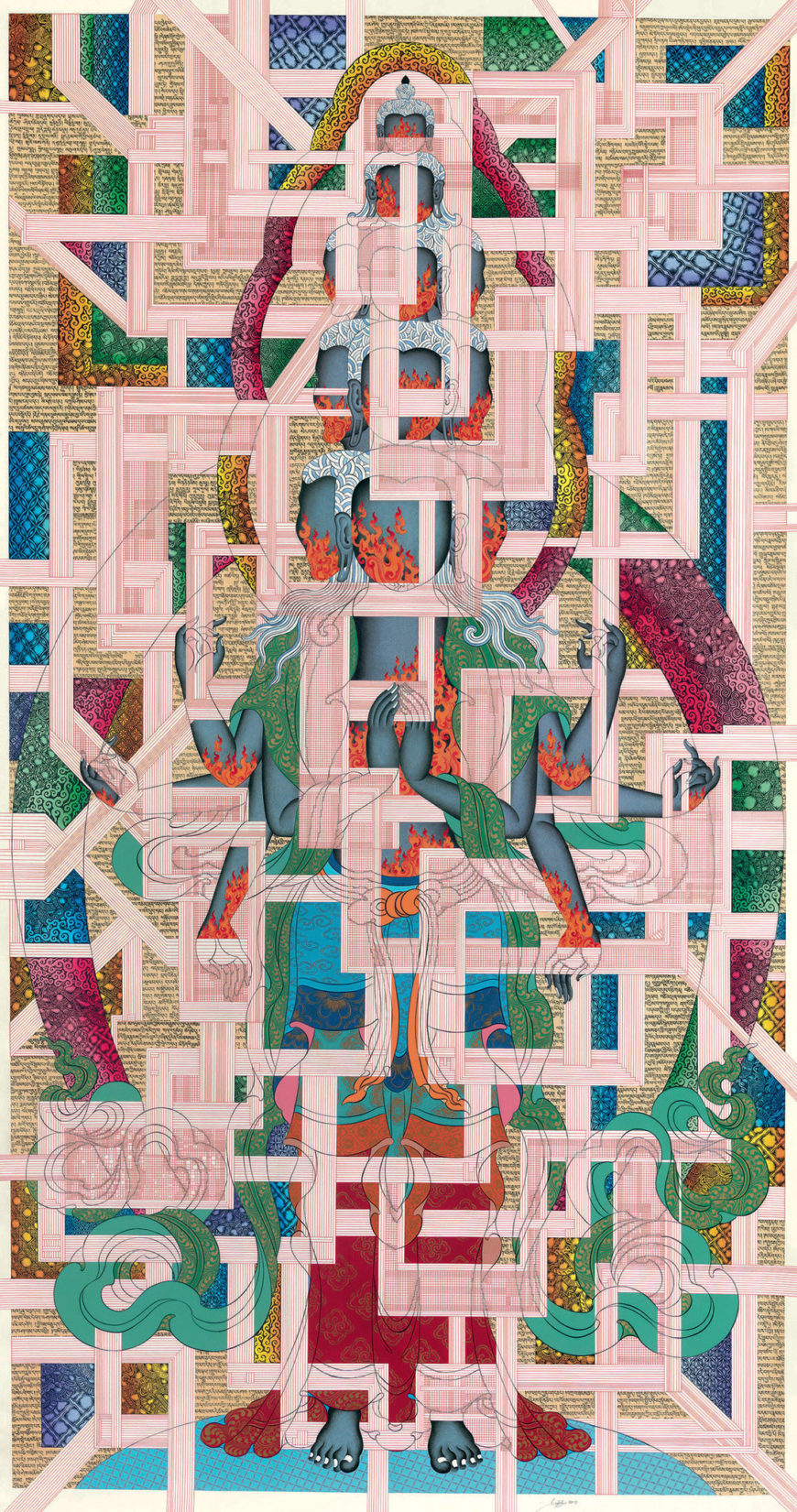
Tenzing Rigdol, Pin drop silence: Eleven-headed Avalokiteshvara, 2013, ink, pencil, acrylic, and pastel on paper, 232.7 x 124.8 cm (The Metropolitan Museum of Art, Gift of Andrew Cohen, in honor of Tenzing Rigdol and Fabio Rossi, 2013) © Tenzing Rigdol
In Tenzing Rigdol’s monumental painting, Pin drop silence: Eleven-headed Avalokiteshvara, we encounter a traditional Buddhist deity—though the artwork itself is anything but conventional in form, material, or meaning. Rigdol uses a combination of acrylic paint, pastel, and pieces of manuscript pages assembled on paper to create a complex rendering of a multi-armed, multi-headed deity—over seven feet tall—who emerges between the interlocking edges of a grid-like overlay. Although the main figure is one that is recognizably sacred for Tibetan Buddhist practitioners, the work itself constitutes a radical departure from historical precedent, and reflects contemporary questions surrounding exile, activism, and cultural heritage.
Rigdol was born in 1982 in Kathmandu, Nepal. His parents fled Tibet in the late 1960s and worked in Nepal’s carpet industry. After training in traditional Tibetan arts, including thangka painting (a painting on fabric depicting a Buddhist subject), sand painting, and butter sculpture, the artist turned to contemporary modes of representation. He is one of the first contemporary Tibetan artists to have his work collected by major institutions, including The Metropolitan Museum of Art. By using culturally specific forms in radically new compositions, Rigdol shifts his work’s focus away from the spiritual symbolism often associated with Tibetan art, and towards more politically charged content.
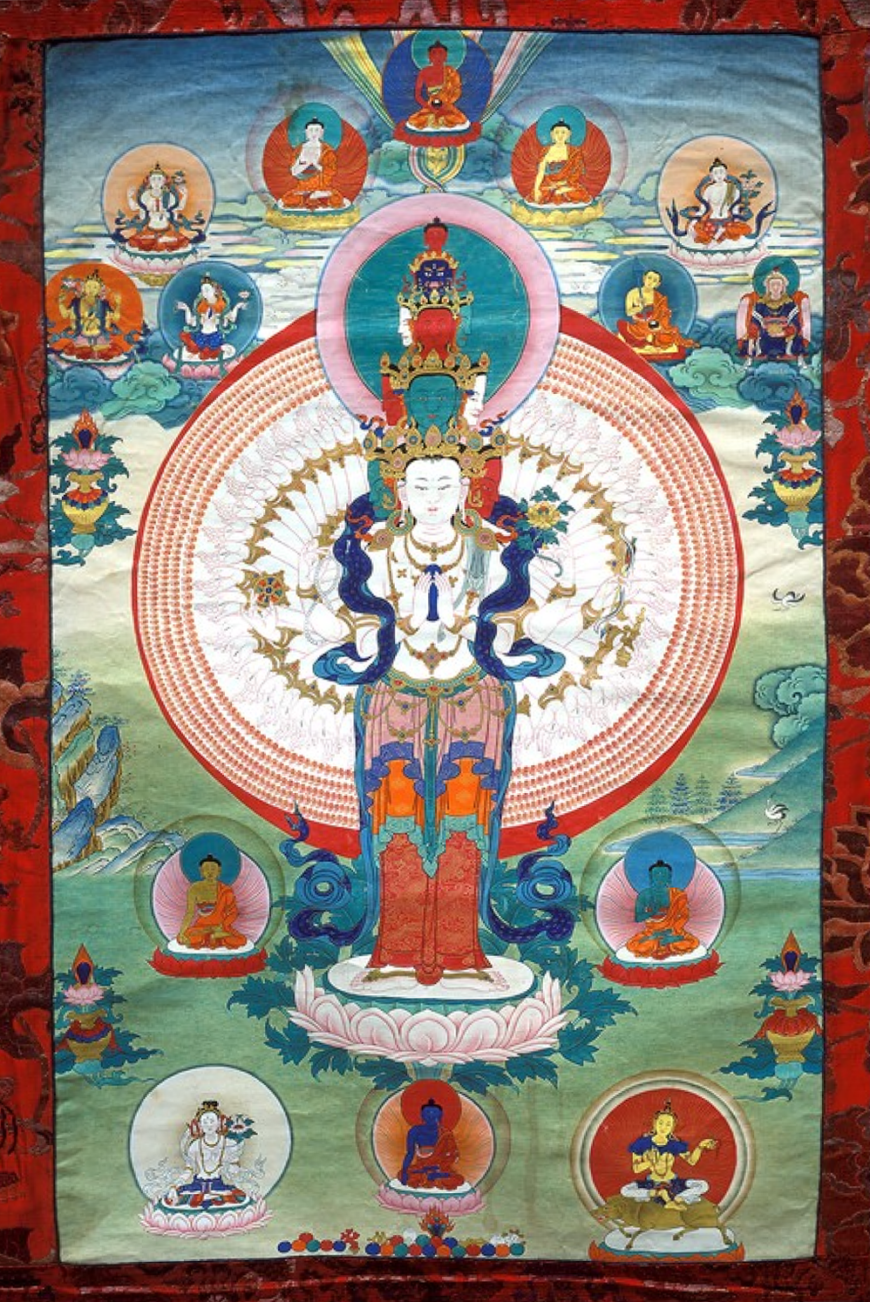
Avalokiteshvara (Bodhisattva & Buddhist Deity) – Sahasrabhujalokeshvara (11 faces, 1000 Hands), 19th century, Eastern Tibet, ground mineral pigment on cotton (private collection)
Who is Avalokiteshvara?
In the center of Pin drop silence is the Buddhist deity known as Avalokiteshvara (Tibetan: Chenrezig). Avalokiteshvara is a bodhisattva (an enlightened being who helps others achieve enlightenment) and is the embodiment of compassion. Avalokiteshvara remains a major figure in Buddhist art throughout Asia (he is known as Guanyin in China). The Dalai Lama is viewed as the earthly incarnation of Avalokiteshvara by practitioners, and as such, plays an important role in Tibetan Buddhism.
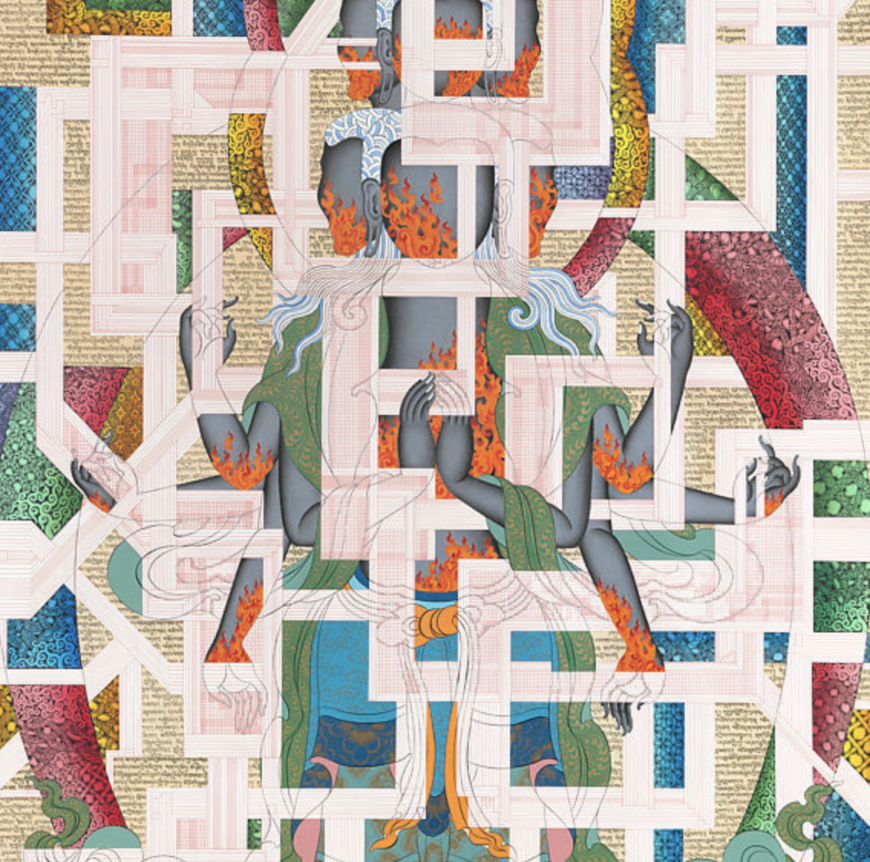
Tenzing Rigdol, Pin drop silence: Eleven-headed Avalokiteshvara (detail), 2013, ink, pencil, acrylic, and pastel on paper, 232.7 x 124.8 cm (The Metropolitan Museum of Art, Gift of Andrew Cohen, in honor of Tenzing Rigdol and Fabio Rossi, 2013) © Tenzing Rigdol
In Pin drop silence, Avalokiteshvara is shown in his eleven-headed form, a reference to his head splitting into several parts in order to more fully observe the world and disseminate compassion. Unlike traditional imagery of Avalokiteshvara, however, none of Rigdol’s Avalokiteshvara’s heads are given a face. For orthodox Tibetan Buddhist practitioners, this omission is significant; buddhas and bodhisattvas are traditionally drawn with very specific guidelines and gridlines in place, including precise renderings of facial features. Here, Rigdol omits these features and seemingly splits the image into pieces with his use of gridlines.
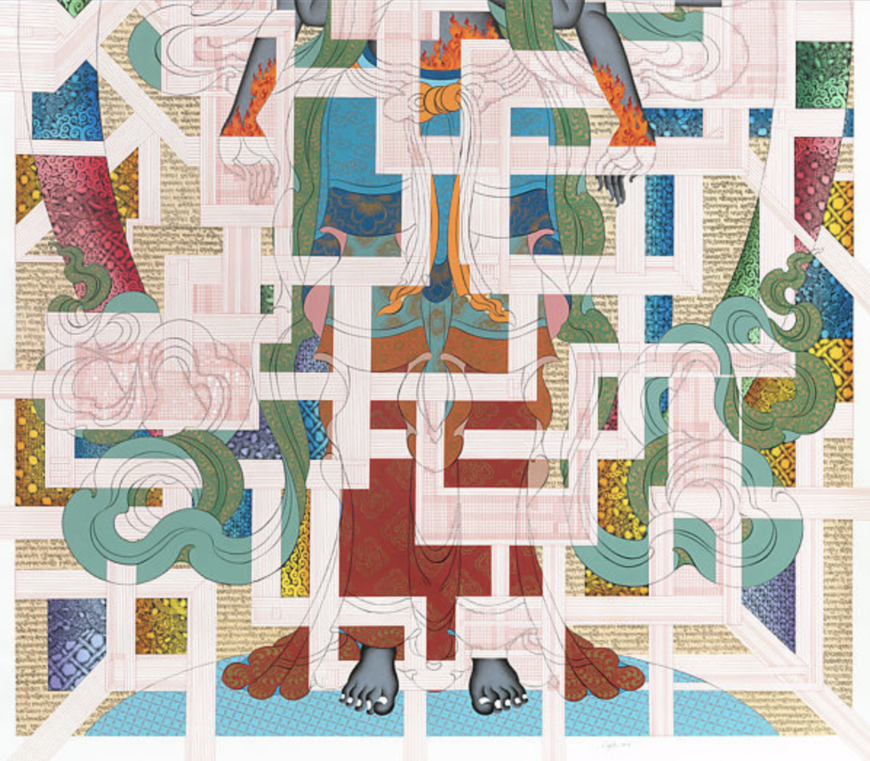
Tenzing Rigdol, Pin drop silence: Eleven-headed Avalokiteshvara (detail), 2013, ink, pencil, acrylic, and pastel on paper, 232.7 x 124.8 cm (The Metropolitan Museum of Art, Gift of Andrew Cohen, in honor of Tenzing Rigdol and Fabio Rossi, 2013) © Tenzing Rigdol
Guidelines and Gridlines
In traditional Tibetan Buddhist painting known as thangka, gridlines were (and are) used as guides to ensure the proper placement and depiction of buddhas (of which there are many, not just the historical Buddha Shakyamuni) and bodhisattvas. The lines are the first step of the process, and they are ultimately covered by the paint—they function merely as guidelines for the artist. Yet Rigdol makes gridlines a major component of Pin drop silence. They divide the image, deconstructing the form of Avalokiteshvara through their presence.
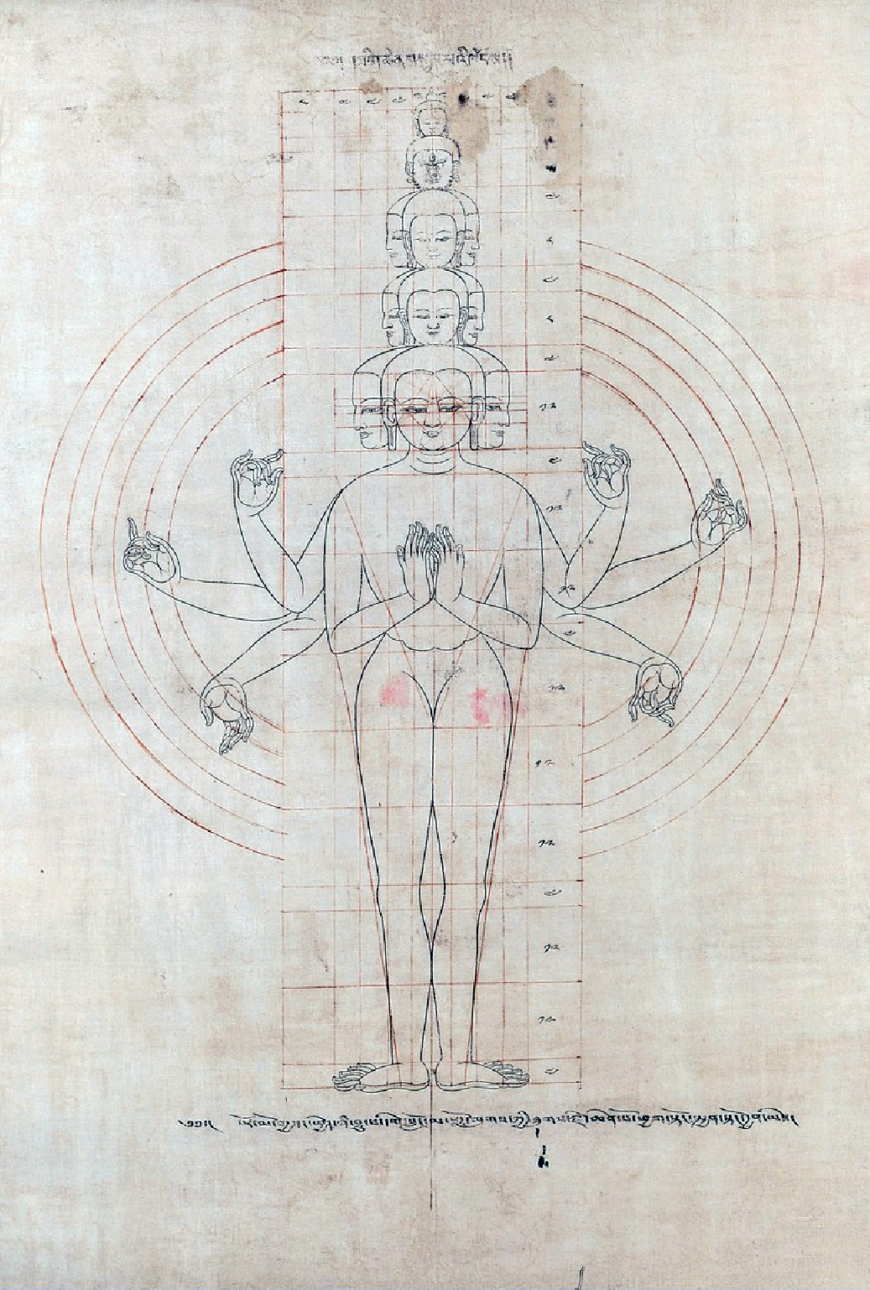
Traditional use of gridlines, Buddhist (private collection)
Rigdol has referenced his early work as a carpet designer in Nepal as an additional point of reference for these gridlines (the design process for carpets uses a matrix as well). Further, some scholars have noted similarities between Rigdol’s affinity for grids and lines and those of the modernist De Stijl artist Piet Mondrian, for whom geometric abstraction held spiritual or utopian value. [1] Rigdol says this about the lines:
Lines are innocent, direct and uncompromising. There is a sense of contentment within the geometric forms. They exert no pressure on me, but instead pull me towards them to look closer.[2]
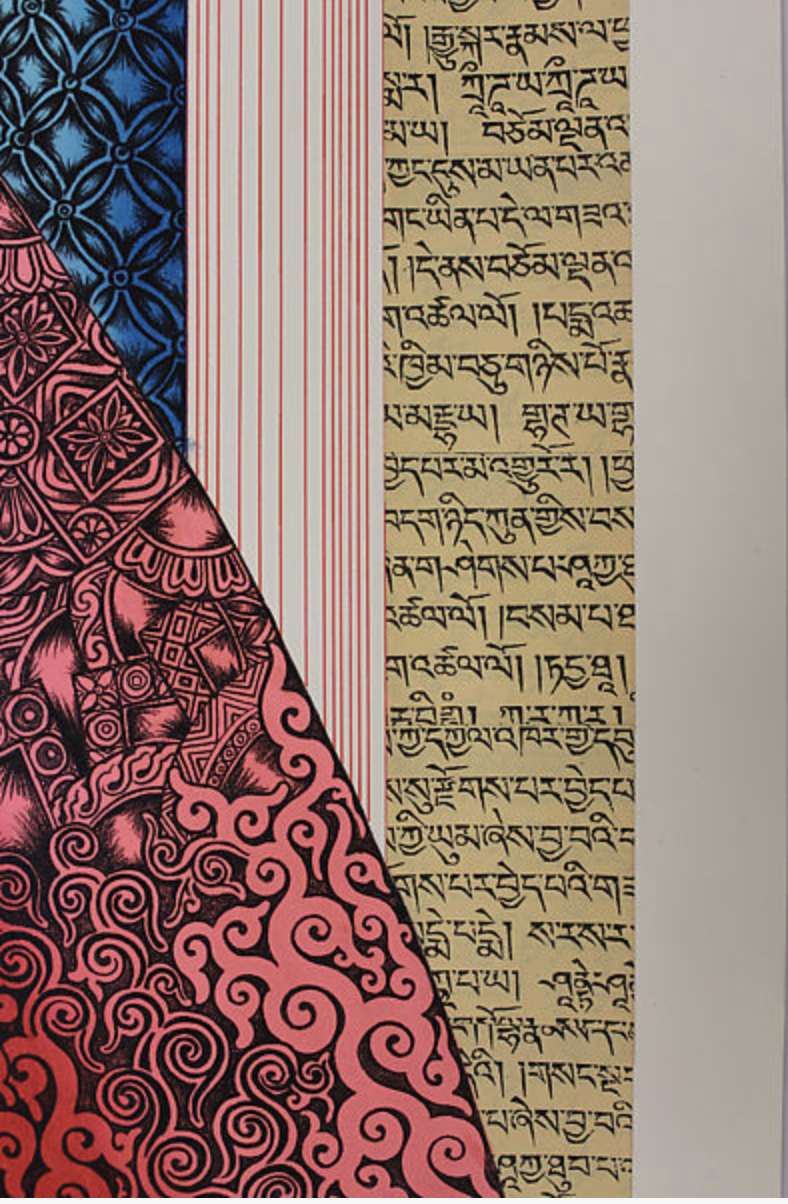
Tenzing Rigdol, Pin drop silence: Eleven-headed Avalokiteshvara (detail), 2013, ink, pencil, acrylic, and pastel on paper, 232.7 x 124.8 cm (The Metropolitan Museum of Art, Gift of Andrew Cohen, in honor of Tenzing Rigdol and Fabio Rossi, 2013) © Tenzing Rigdol
Replacing the Background
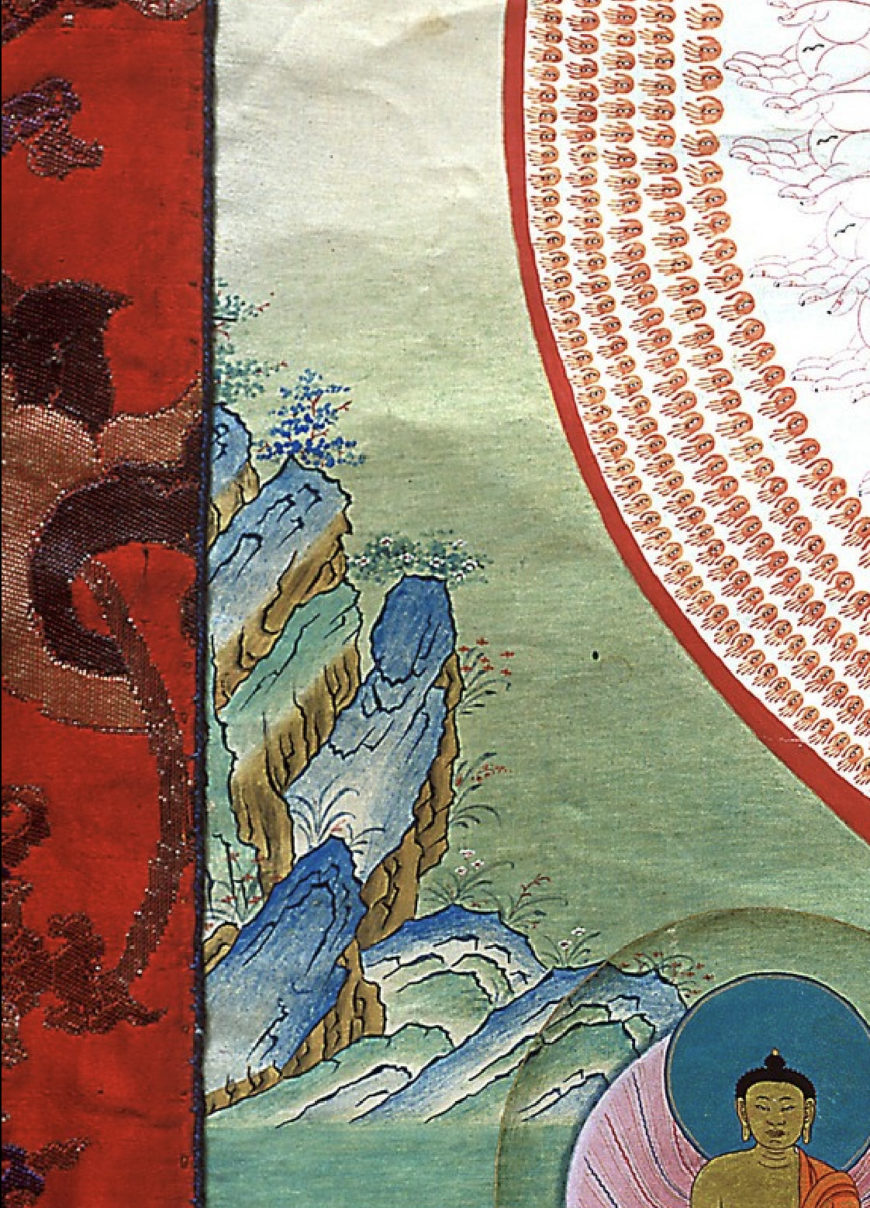
Detail of Avalokiteshvara, 19th century, Eastern Tibet, ground mineral pigment on cotton (private collection)
The gridlines in Rigdol’s work are constructed from intersecting fragments of manuscript pages, which hold a personal meaning for the artist. Rigdol’s family had been in business as ink manufacturers in Tibet prior to their escape to Nepal in the late 1960s. This ink was used by monasteries to print the Buddhist manuscript pages used by monks, nuns, and lay Buddhist practitioners.
The script on these pages is known as u-chen, and is utilized across the Tibetan plateau. (Though the dialects differ across the region, this script can be read by many Tibetans). In traditional Tibetan thangka, the backgrounds often incorporated influences from Chinese landscape painting. By “replacing” that landscape with the unifying Tibetan script, Rigdol reimagines “tradition,” questioning the role of Chinese landscape painting in the history of Tibetan art.
As he notes:
Historically, the landscape elements in Tibetan thangka painting—the clouds, the rivers and so on—were influenced by Chinese painting. They later got an upgrade in Tibetan art. I have often said, sometimes jokingly and sometimes seriously, that in adopting Chinese style landscapes in their paintings, Tibetan artists of the past were foretelling the colonization of Tibet’s land, sky, rivers and mountains by the Chinese. In 1959, when Tibet lost its country, the prophecy was fulfilled.[3]
In this passage, Rigdol refers to a series of events in the 1950s that established Chinese rule over Tibet. There exist two opposing narratives about this period: the Chinese government and Chinese history books refer to it as the “Peaceful Liberation of Tibet,” whereas Tibetans view the period as a devastating takeover of their land by colonizing forces, the “Chinese invasion of Tibet.” Although many decades have now passed, there is still great strife in the region (now called the Tibet Autonomous Region, or TAR), resulting in ongoing political protests and efforts to silence dissent.

Tenzing Rigdol, Pin drop silence: Eleven-headed Avalokiteshvara (detail), 2013, ink, pencil, acrylic, and pastel on paper, 232.7 x 124.8 cm (The Metropolitan Museum of Art, Gift of Andrew Cohen, in honor of Tenzing Rigdol and Fabio Rossi, 2013) © Tenzing Rigdol
Representing self-sacrifice
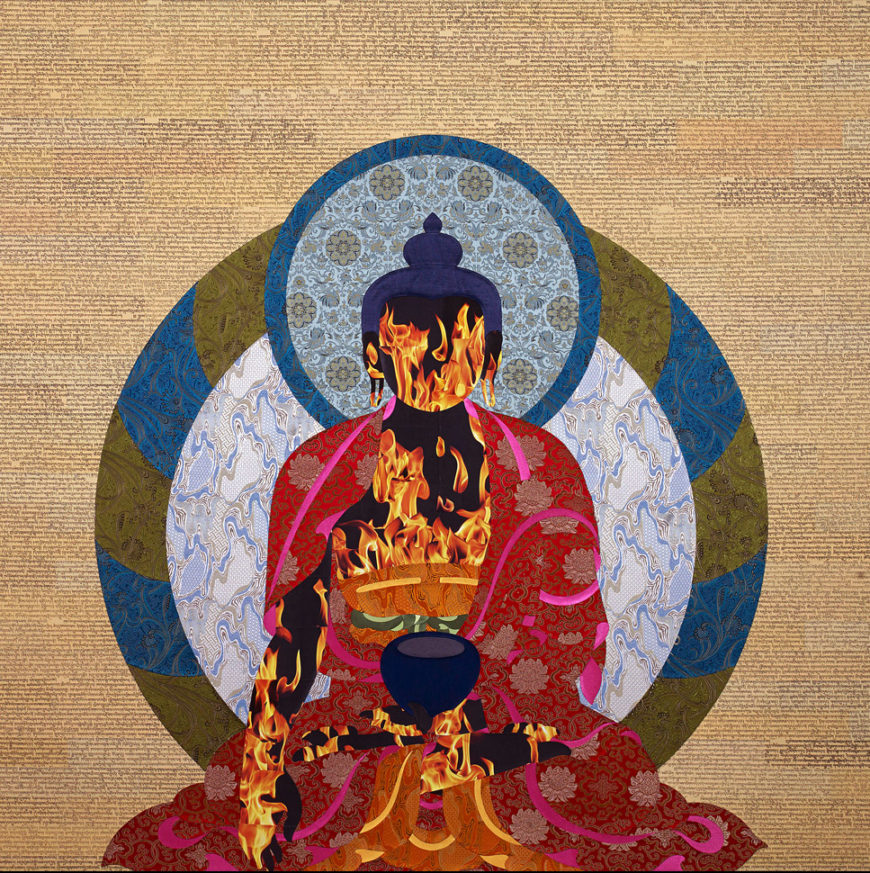
Tenzing Rigdol, My World Is in Your Blind Spot (1 of 5 panels), 2014, silk brocade, scripture, photographs, 72 x 72” (182 x 182 cm each) (image courtesy of Tenzing Rigdol and Rossi & Rossi) © Tenzing Rigdol
Rigdol incorporates flames throughout the body of the deity, a reference to the ongoing self-immolation by Tibetans. Since 2009, 156 Tibetans have publicly protested the rule of the Chinese government by setting themselves on fire, often resulting in death. [4]
Another work by Rigdol, My World Is in Your Blind Spot, incorporates these flames. This work is a direct reference to the lack of attention that these devastating protests have had in the international community. My World Is in Your Blind Spot is a series of five works that shows buddhas in meditative postures, with flames appearing within the contours of their bodies. Rigdol photographed the flames and then cut the images apart before reassembling them, claiming a preference for a “calm” and dignified flame rather than an aggressive flame to honor the sacrifice of so many Tibetans. The casual viewer of Rigdol’s work is likely unaware of these protests. While the panels are beautiful to look at, they are devastating to comprehend. This political statement would not be permitted in the Tibet Autonomous Region because of strict censorship imposed by China, instead it was made in exile.
Rigdol is one of many contemporary Tibetan artists who has never set foot in Tibet. In exile communities scattered around the world, artists have established a visible global presence by creating group exhibitions such as Waves on the Turquoise Lake (2006), Traditions Transformed (2010) and Anonymous (2013–2015), all of which showcased work by artists located both in the Tibet Autonomous Region and those working in exile communities. Many of these artists incorporate Buddhist elements in their work, although in some cases this inclusion is more of a nod to a cultural connection than to religious identity (artists may or may not be Buddhist practitioners, and the work in these exhibitions was rarely meant to function in a sacred manner). Yet, the relationship to Tibet is firmly established, as it is in Pin drop silence: Eleven-headed Avalokiteshvara.




